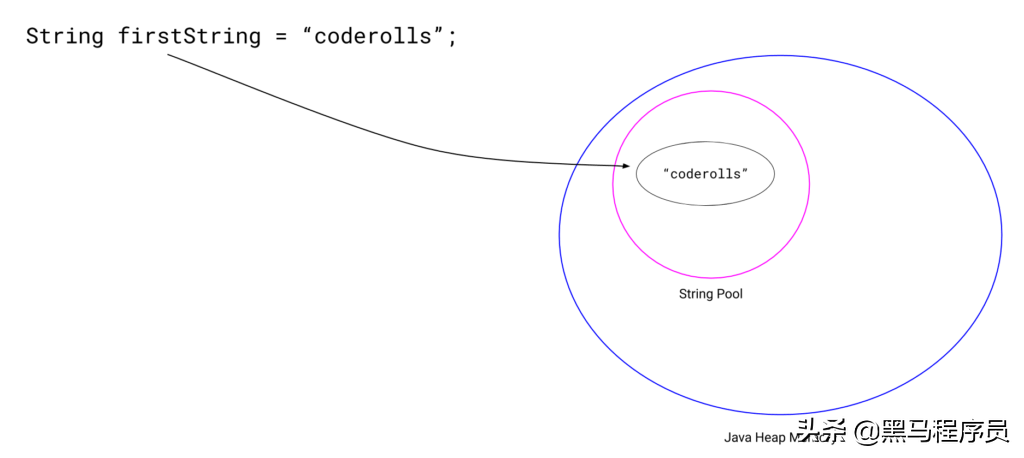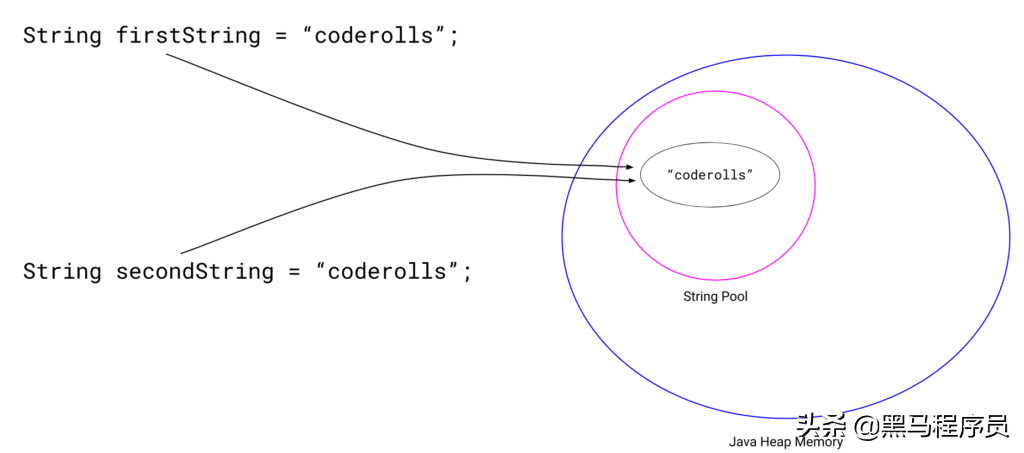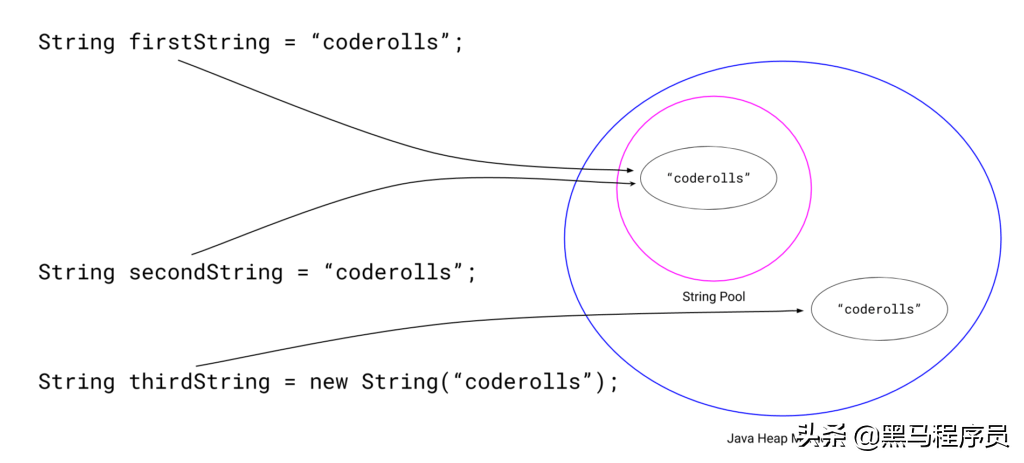介绍
字符串是Java中的一个特殊类。我们在Java程序中经常使用字符串,所以比较两个字符串是Java中的一种常见做法。在本文中,我尝试回答关于字符串的最常见问题,比如:“如何在Java中比较字符串?”
在验证、排序、引用匹配等过程中,比较字符串非常有用。
我列出了在Java中比较字符串的三种不同方法。
使用equals()方法(比较内容)
使用==操作符(比较对象引用)
使用compareTo()方法(按字母顺序比较字符串)

1.使用Equals() 方法比较字符串
这样,我正在使用 .equals() String类的实例方法。.equals() 方法原本 是 Object 类方法,而String类会覆盖它。
equals() 方法比较两个字符串的值相等性,无论它们在逻辑上是否相等。
equals() String类中的方法将另一个字符串作为参数,并将其与指定的字符串进行比较。true 当且仅当参数字符串不为null且包含与指定字符串相同的字符时,它返回 。
public boolean equals(Object anObject) It compare this string with the argument strings and return true if the argument is not null and contains the same character as the specified string. param - another string returns - true - if argument is not null and it contains same characters as the specified string 13 ex. firstString.equals(secondString) 14 // returns true if and only if the secondString is not null and contains the same characters as firstString.
已要求程序使用以下equals() 方法比较字符串 :
/**
2
* A Java program to compare two strings using equsls()
3
* and equalsIgnoreCase() method of the String.
4
*
5
* @author Gaurav Kukade at coderolls.com
6
*/
7
8
public class CompareUsingEquals {
9
10
public static void main(String[] args) {
11
String firstString = "coderolls";
12
String secondString = "javablog";
13
String thirdString = "coderolls";
14
String fourthString = "CodeRolls";
15
16
System.out.println("Comparing strings using equals() and equalsIgnoreCase() method\n");
17
18
// Using equals() method
19
System.out.println(firstString.equals(secondString));
System.out.print("firstString.equals(thirdString) : ");
System.out.println(firstString.equals(thirdString));
/*
* Using equalsIgnoreCase() method to ignore
* case consideration (i.e. Capital or small) of both the strings.
*/
System.out.print("firstString.equalsIgnoreCase(fourthString) : ");
System.out.println(firstString.equalsIgnoreCase(fourthString));
}
}
输出:
Comparing strings using equals() and equalsIgnoreCase() method firstString.equals(secondString) : false firstString.equals(thirdString) : true firstString.equalsIgnoreCase(fourthString) : true
2. 使用==操作符比较字符串
在String中,==操作符用于比较给定字符串的引用,这取决于它们是否引用相同的对象。
当使用==操作符比较两个字符串时,如果字符串变量指向相同的java对象,则返回true。否则,它将返回false。
我已经给出了一个Java程序来比较使用==操作符如下:
/ **
*一个Java程序,用于使用==运算符比较字符串。
*
* ==运算符会终止是否两个字符串都引用
*到相同的String对象。
* /
public class CompareUsingEqualsToOperator {
public static void main(String[] args) {
String firstString = "coderolls";
String secondString = "javablog";
String thirdString = "coderolls";
//建具有与firstString或thirdString相同值的新String对象
String fourthString = new String("coderolls");
System.out.println("Comparing strings using == operator \n");
System.out.print("firstString == secondString : ");
System.out.println(firstString == secondString);
/ *
*这里firstString和thirdString指的是相同的String对象
* /
System.out.print("firstString == thirdString : ");
System.out.println(firstString == thirdString);
/*
* Here firstString and fourthString have same value
* but they are referring to the different String object.
*
* hence it will print 'false'
*/
System.out.print("firstString == fourthString : ");
System.out.println(firstString == fourthString);
}
}
输出:
Comparing strings using == operator firstString == secondString : false firstString == thirdString : true firstString == fourthString : false
使用==操作符进行字符串比较的问题
大多数初学Java的开发人员都会犯这个错误,他们使用==操作符比较两个字符串。
逻辑上,它们必须检查两个字符串是否包含相同的字符序列。
在Java字符串中,==操作符用于检查字符串对象和equals()方法的引用,equals()方法用于检查两个字符串的值是否相等。
== -检查引用是否相等
equals()——检查值是否相等
当我们将字符串值赋给字符串变量时,JVM将检查字符串池中是否已经存在具有相等值的字符串。如果它不在字符串池中,它将被添加到常量池中,并返回对该字符串对象的引用。
如果它存在于字符串池中,则返回对该字符串对象的内存地址的引用。
下面的图像显示了同样的图形解释。

在上方,我们firstString指向字符串池中的“ coderolls”字符串。
如果我们将相等的值分配给另一个字符串变量,JVM将检查具有该值的字符串是否出现在字符串常量池中。
由于在前面的步骤中已经创建了具有该值的string对象,所以另一个string变量开始引用前面创建的string对象实例。
下面的图像显示了“firstString”和“secondString”的图形说明,它们指向字符串池中的“coderolls”字符串。

当我们使用new 运算符创建字符串时,将创建一个 新的字符串对象并将其存储在Java堆空间中。

在上方,我们可以看到' firstString'和' secondString'指向coderolls字符串池中的“ ”字符串,而' thirdString'指向coderollsJava堆空间中的“ ”。
如果参数字符串在词法上大于指定字符串,也就是说,如果参数字符串在指定字符串之后,那么它返回一个负整数。(参数字符串>指定字符串)
如果参数字符串在字典上比指定字符串小,也就是说,如果参数字符串在指定字符串之前,则返回正整数。(参数字符串<指定字符串)
如果两个字符串都是lexicographic equals,则返回0。(参数字符串=指定字符串)
如果想忽略两个字符串的情况,请使用compareToIgnoreCase()方法。
我已经给出了一个使用compareTo()方法比较字符串的程序。它还包含一个用compareToIgnoreCase()方法忽略案例的案例。
/**
2
* A Java program to compare strings using compareTo()
3
* and compareToIgnoreCase() method.
4
*
5
* compareTo() compare strings lexicograpgically.
6
*
7
* @author Gaurav Kukade at coderolls.com
8
*/
9
10
public class CompareUsingCompareTo {
11
12
public static void main(String[] args) {
13
14
String firstString = "java";
15
String secondString = "coderolls";
16
String thirdString = "sql";
17
String fourthString = "CodeRolls";
18
19
System.out.println("Comparing strings using compareTo() and compareToIgnoreCase() method\n");
20
21
// Using compareTo() method
22
System.out.println(firstString.compareTo(secondString));
System.out.print("firstString.compareTo(thirdString) : ");
System.out.println(firstString.compareTo(thirdString));
/*
29
* Using compareToIgnoreCase() method to ignore
30
* case consideration (i.e. Capital or small) of both the strings.
31
*/
System.out.print("secondString.compareToIgnoreCase(fourthString) : ");
System.out.println(secondString.compareToIgnoreCase(fourthString));
}
}
输出:
Comparing strings using compareTo() and compareToIgnoreCase() method firstString.compareTo(secondString) : 7 firstString.compareTo(thirdString) : -9 secondString.compareToIgnoreCase(fourthString) : 0
结论
我们可以用下面的方法来比较字符串:
在字符串中使用equals()方法:equals()方法用于检查字符串值是否包含相同的字符序列。
使用==操作符:==操作符检查两个字符串的引用是否相等,是否指向同一个字符串对象。
使用compareTo()方法:compareTo()方法用于按字母顺序检查字符串。查看关于如何按字典顺序比较字符串的详细文章。
大多数初学Java的开发人员在比较字符串时都会出错。他们想要检查字符串的内容,但是他们使用==操作符来检查它。
总是建议使用equals()方法根据字符串的内容比较字符串。